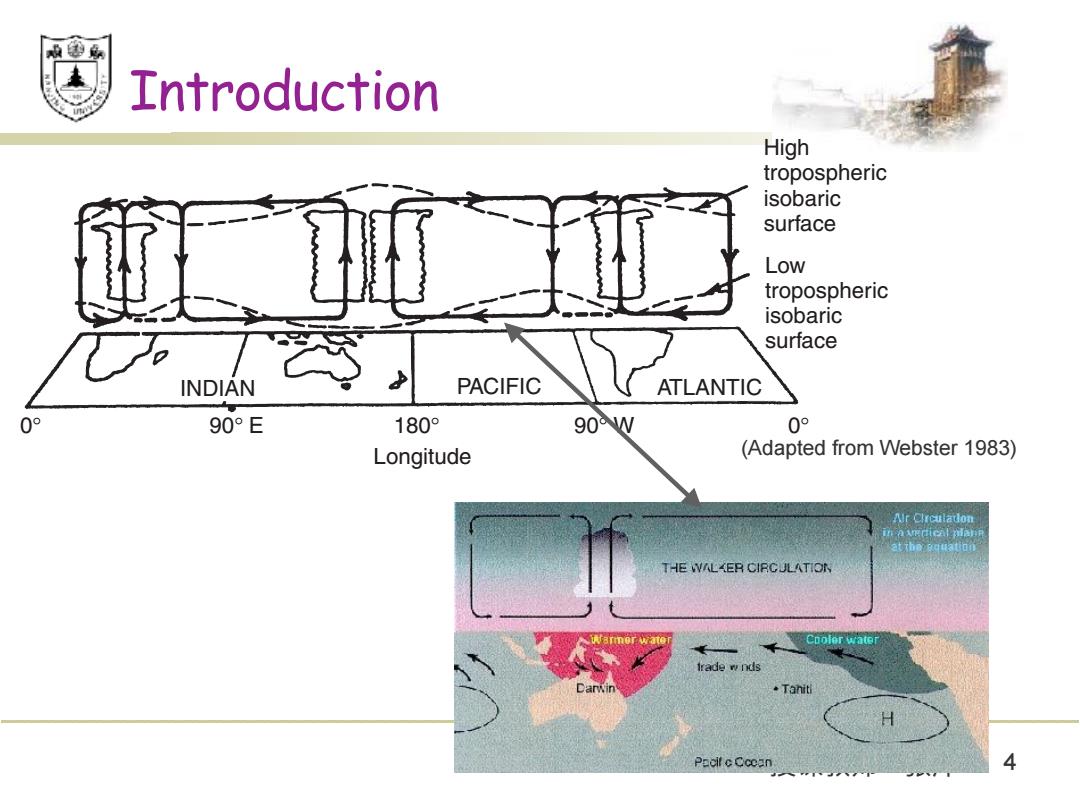正在加载图片...

及图斯 Introduction High tropospheric isobaric surface Low tropospheric isobaric surface INDIAN PACIFIC ATLANTIC 0° 90°E 180° 90W 0° Longitude (Adapted from Webster 1983) Ar Clreulaton in avedical plabe athgatt THE WALKER CIRCULATION rade w nds ·Tahiti Pacil c Cccan授课教师:张洋 4 Introduction WALKER CIRCULATION K-M Lau, NASA/Goddard Space Flight Center, Greenbelt, MD, USA S Yang, NOAA/NWS/NCEP, Climate Prediction Center, Camp Springs, MD, USA Copyright 2002 Elsevier Science Ltd. All Rights Reserved. doi:10.1006/rwas.2002.0450 Lau, K-M NASA/Goddard Space Flight Center, Greenbelt, MD 20771, USA Yang, S NOAA/NWS/NCEP, Climate Prediction Center, Camp Springs, MD 20746, USA Introduction The term Walker Circulation was first introduced in 1969 by Professor Jacob Bjerknes, referring to the large-scale atmospheric circulation along the longitude–height plane over the equatorial Pacific Ocean. The Walker Circulation features low-level winds blowing from east to west across the central Pacific, rising motion over the warm water of the western Pacific, returning flow from west to east in the upper troposphere, and sinking motion over the cold water of the eastern Pacific. Since Bjerknes’s introduction of the Walker Circulation, there have been reports of similar east–west circulation cells spanning different longitudinal sectors along the Equator. Today, the Walker Circulation generally refers to the totality of the circulation cells as shown in Figure 1. Bjerknes originally named the Pacific east–west circulation the Walker Circulation because he considered it the key part of Sir Gilbert Walker’s Southern Oscillation (see El Nino and the Southern Oscillation: Observation (0148)). He interpreted the Walker Circulation as an atmospheric circulation driven by the gradient of sea surface temperature along the Equator and suggested that the characteristics of the Walker Circulation were largely determined by the coupling between the tropical atmosphere and oceans. Bjerknes’s work on the Walker Circulation marked an important milestone toward our basic understanding of the dynamics of zonal atmosphere–ocean coupling along the equatorial Pacific Ocean. Although his results were based on very limited data, Bjerknes’s original conjecture that the year-to-year variation of the Walker Circulation is closely tied to that of the Southern Oscillation and El Nin˜o has been confirmed by a large number of observational and modeling studies during the several decades since his first report. Climatology and Variability Annual Mean Thanks to the advance in satellite observations and improved assimilation of observations into global general circulation models, we have now a much more detailed and quantitative description of the Walker Circulation. We know that the tropical wind is made up of rotational and divergent components. The former is directly related to the effects of the rotation of the Earth and the latter to the overturning circulation, driven by atmospheric heating processes. The Walker Circulation and associated overturnings in the equatorial plane should refer only to the divergent component of the wind. Figure 2A shows the annual climatology (the mean state of all months) of the overturning circulations along the equatorial plane as streamlines constructed from the divergent zonal and vertical winds. It can be seen that the major rising High tropospheric isobaric surface Low tropospheric isobaric surface INDIAN PACIFIC ATLANTIC 0° 90° E 180° 90° W 0° Longitude 0450-F0001 Figure 1 Schematic view of the east–west atmospheric circulation along the longitude–height plane over the Equator. The cell over the Pacific Ocean is referred to as the Walker Circulation. (Adapted from Webster (1983).) 0450-P0005 0450-P0010 0450-P0015 0450-P0020 WALKER CIRCULATION 1 rwas.2002.0450 26/4/02 13:03 Ed:: M. SHANKAR No. of pages: 6 Pgn:: seetharama (Adapted from Webster 1983)